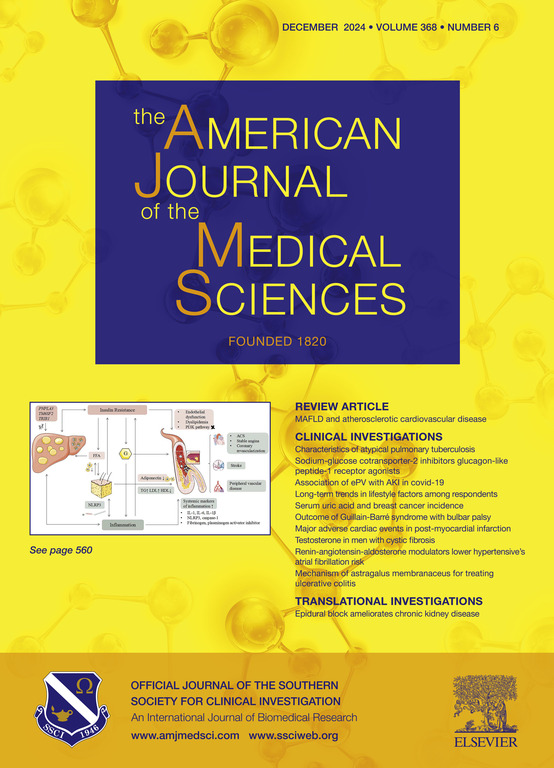Association of family history of myocardial infarction or stroke with vascular parameters in healthy individuals: the EVasCu study and MUJER-EVA project
IF 1.8
4区 医学
Q2 MEDICINE, GENERAL & INTERNAL
引用次数: 0
Abstract
Background
The role of a family history of cardiovascular events in predisposing patients to cardiovascular diseases is recognized. Arterial stiffness, as measured by pulse wave velocity (PWv), is an emerging risk indicator. This study explores the association between a family history of cardiovascular events (i.e., myocardial infarction and stroke) and vascular and blood pressure parameters in healthy individuals.
Methods
The cross-sectional EVasCu study in Cuenca, Spain, enrolled 390 healthy adults. Vascular (aortic PWv [aPWv], cardio-ankle vascular index [CAVI], ankle-brachial index [ABI], augmentation index [AIx@75]) and blood pressure (systolic blood pressure [SBP], diastolic blood pressure [DBP], pulse pressure [PP]) parameters, as well as other covariates, were measured. ANOVA and ANCOVA were used to assess the association between family history of myocardial infarction and stroke and vascular and blood pressure parameters.
Results
The study group included 246 females and 144 males (Age: 42.05 ± 13.15 years). According to the unadjusted analyses, a family history of myocardial infarction was associated with increased SBP and PP (p = 0.015 and p = 0.012, respectively), with PP remaining significantly elevated in females (p = 0.003). These associations were largely attenuated after adjustment for sociodemographic, clinical, and lifestyle variables; however, PP remained significantly greater in females with a family history of myocardial infarction (p = 0.030), as supported by z score normalization (p = 0.036). Additionally, a family history of stroke was associated with significantly increased aortic pulse wave velocity (aPWv) in both the total sample and in females (p < 0.001 and p = 0.002, respectively), findings that remained significant after z score adjustment.
Conclusions
Arterial stiffness emerges as a potential bridge between genetic predisposition and cardiovascular risk. Recognizing the importance of a family history of cardiovascular events in risk assessment and leveraging noninvasive measures of arterial stiffness could refine preventive strategies.
健康人心肌梗死或脑卒中家族史与血管参数的关系:EVasCu研究和MUJER-EVA项目
背景:心血管事件家族史在患者易患心血管疾病中的作用已得到认可。动脉硬度,作为测量脉搏波速度(PWv),是一个新兴的风险指标。本研究探讨了健康个体心血管事件家族史(即心肌梗死和中风)与血管和血压参数之间的关系。方法:西班牙昆卡的横断面EVasCu研究纳入了390名健康成人。测量血管(主动脉PWv [aPWv]、心踝血管指数[CAVI]、踝肱指数[ABI]、增强指数[AIx@75])、血压(收缩压[SBP]、舒张压[DBP]、脉压[PP])参数及其他协变量。采用方差分析(ANOVA)和方差分析(ANCOVA)评估心肌梗死和卒中家族史与血管和血压参数之间的关系。结果:研究组女性246例,男性144例,年龄42.05±13.15岁。根据未经调整的分析,心肌梗死家族史与收缩压和PP升高相关(p = 0.015和p = 0.012),女性PP仍显著升高(p = 0.003)。在调整了社会人口学、临床和生活方式变量后,这些关联在很大程度上减弱了;然而,有心肌梗死家族史的女性的PP仍然显著更高(p = 0.030),z评分归一化支持了这一点(p = 0.036)。此外,卒中家族史与总样本和女性的主动脉脉波速度(aPWv)显著增加相关(p < 0.001和p = 0.002),这一发现在z评分调整后仍然显著。结论:动脉僵硬是遗传易感性和心血管风险之间的潜在桥梁。认识到心血管事件家族史在风险评估中的重要性和利用动脉僵硬的非侵入性测量可以改进预防策略。
本文章由计算机程序翻译,如有差异,请以英文原文为准。
求助全文
约1分钟内获得全文
求助全文
来源期刊
CiteScore
4.40
自引率
0.00%
发文量
303
审稿时长
1.5 months
期刊介绍:
The American Journal of The Medical Sciences (AJMS), founded in 1820, is the 2nd oldest medical journal in the United States. The AJMS is the official journal of the Southern Society for Clinical Investigation (SSCI). The SSCI is dedicated to the advancement of medical research and the exchange of knowledge, information and ideas. Its members are committed to mentoring future generations of medical investigators and promoting careers in academic medicine. The AJMS publishes, on a monthly basis, peer-reviewed articles in the field of internal medicine and its subspecialties, which include:
Original clinical and basic science investigations
Review articles
Online Images in the Medical Sciences
Special Features Include:
Patient-Centered Focused Reviews
History of Medicine
The Science of Medical Education.

 求助内容:
求助内容: 应助结果提醒方式:
应助结果提醒方式:


